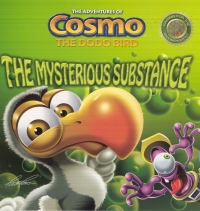| ________________
CM . . . . Volume XVIII Number 6 . . . . October 7, 2011
excerpt:
The Mysterious Substance is part of a series of picture books featuring the last of the dodos, Cosmo, and his friend, 3R-V the spaceship, who was made by an Earth scientist according to the principles of reduce, re-use and recycle. The book has a page-length introduction for each character at the front and back, separate from the story, for those readers who have not read the other books in the series and need some background information on who the friends are and what their objective (to find other dodos surviving somewhere in the universe) is. The format is similar to that of daily cartoons or some comics in that the two main characters are on a continuing quest, the individual episodes of which are the material of each separate book and at the end of which the two will return to their journey, leaving the day's adventure and their newfound friends behind. In this story, Cosmo and 3R-V land on a planet "just like Earth" and follow the footprints they find there, hoping to find dodos, only to find a workman named Fabrico about to unload the waste from his factory into a river. After trying to persuade Fabrico not to do this, the pair save him from falling down a pit while running away from a savage lizard mutated from the influence of the aforementioned waste material. Fabrico thanks Cosmo and 3R-V and acknowledges that one must never abuse nature. The two leave, after promising to keep in touch. The Mysterious Substance (and, I guess, the entire "Cosmo" series) has a strong message of environmentalism, so strong that the story functions as a vehicle for the message. As such, the following comments will mostly address whether or not the message is being effectively relayed to the target audience, the young person reading alone or with the help of an adult. I would like to begin by noting that the plot, as can be seen summarized above, is fine for the adventure-of-the-day installment format, giving the reader an immediate problem and antagonist in the form of Fabrico the Workman and his flask of green gunk. Things escalate rapidly as Fabrico is reluctant to think about the dangers of dumping waste, and then they come to a head in an exciting transformation and chase scene before being resolved with a satisfying rescue. The ending is rounded off with the heroes' departure, leading to a feeling of expectation for, and continuation with, the next adventure. However, I find the plot is too generic for the purpose of promoting environmentalism as applies to the young reader, in the form of an awareness of nature and an enthusiasm for protecting it. The complete lack of any specific detail in the text, especially, creates quite vague impressions: of pollution, dumping and factories being bad, of nature being good, and of workers in factories being very stupid. What exactly nature comprises (the river, the grass and the lizard, for example) and how delicate, yet how hardy, the environment can be (as the mutated lizard recovers from the effects of the gunk after some time); these are just two important things that could have been touched on by the text since they were already in the illustrations and are also relevant to the reader as they can be applied directly to the reader's own daily environment and life. It is difficult to ask the young reader to appreciate fully the situation of being a factory worker told to dump toxic waste, who does so because "I don't get paid to think!" – that is more related to the concerns and, indeed, the experience, of an adult. What does pollution mean? What is waste? Why was the gunk harmful to the river, and why was Fabrico told to dump it there (convenience, perhaps)? What could Fabrico do with the gunk so as not to pollute anything, or how could he avoid gunk altogether? These are questions that might be discussed between an adult and child reader that are already embedded in the text but are not given the opportunity to surface. The illustrations are done in brightly coloured CG, with round-featured characters of which the eyes are greatly emphasized. Think SpongeBob Squarepants, simplified and in CG. Most of the background or landscape details are pared down, such as grass and trees, to soft blurry shapes. This was perhaps in order to bring the reader to focus more on the characters (which does happen, as they are the more strongly coloured and clearly defined), but has the unfortunate side effect of making the professed object of attention, nature, look rather monotonous and boring. The flask of waste, while having some green fumes issuing from the mouth, is a rotund container half-full of some clear, bubbly stuff of a sour-apple green colour and covered with white sparkle-like effects. In fact, it looks quite attractive, which rather contradicts the text. Overall, The Mysterious Substance is a fun adventure story using accessible characters and storytelling to give its reader the general idea that the environment is something to be protected. For any deeper knowledge, one should look elsewhere, but, for the purpose of entertainment and as a beginning point for an interest in the environment, it is alright. Recommended. Saeyong Kim is studying for a Master of Arts in Children's Literature at the University of British Columbia, BC.
To comment
on this title or this review, send mail to cm@umanitoba.ca.
Copyright © the Manitoba Library Association. Reproduction for personal
use is permitted only if this copyright notice is maintained. Any
other reproduction is prohibited without permission.
NEXT REVIEW |
TABLE OF CONTENTS FOR THIS ISSUE
- October 7, 2011.
AUTHORS |
TITLES |
MEDIA REVIEWS |
PROFILES |
BACK ISSUES |
SEARCH |
CMARCHIVE |
HOME |
